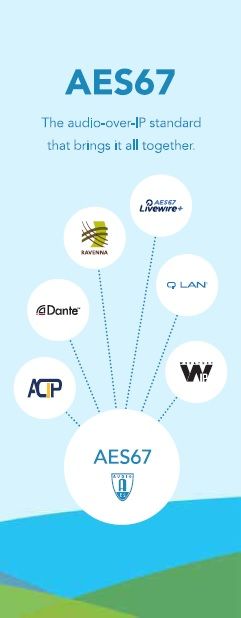
Quick Bio
Name: Rich Zwiebel
Title: Vice President, Systems Strategy
Company: QSC Audio Products
AES67 has been around for about two years now, and while many in the industry have embraced it, many others do not really understand what it is, and what it is not.
History of Networking
It’s useful to start with some background on audio networking. Back in 1998, Peak Audio developed CobraNet as the first widely used “audio network.” While it was revolutionary for its day, not many people understood why anyone would want to run audio over a network.
Over time, the reasons for doing so became clear, and within a few years, it was the de facto industry standard, with more than 50 companies using it in their products. Since it was so widely accepted, without any significant competing option, there was industry-wide interoperability between most brands of products in the installed audio market.
In 2001, Peak Audio was acquired by Cirrus Logic, which continued to support CobraNet, but it did not focus on new development, as it was not applicable to the consumer market. CobraNet supported 64 bidirectional channels over 100Mb ethernet and was not IP based. As the IT industry advanced, this became a limitation, and started to become dated. Professional audio manufacturers began to look elsewhere for a more up-to-date solution.
IP-Based Networks
At the same time, the IT industry was making huge advances at a very good pace. And a real standard was developing that was supported by the network world at large. In particular, it was supported by large network hardware manufacturers such as Cisco and HP. That standard is IP, and it normally includes certain key features such as 1588, QOS, RTP, etc.
Seeing a need to embrace these IT industry standards, audio manufacturers began to develop their own IP-based audio networks. These include Q-LAN and Dante, and on the broadcast side, Livewire, Ravenna, and Wheatnet-IP.
If you were to examine these various networks, you would see that while they are all quite similar, they are each optimized for the specific needs of each target market.
Yet, many engineers in the audio industry could not help but notice how similar they were since each company chose to use the standards of the IT industry.

The Beginning of AES67
Broadcasters, end users, engineers, and others from various manufacturers started to discuss this and decided to create an interoperability standard under the auspices of the Audio Engineering Society (AES). The purpose of this effort was not to develop yet another competing audio network— lord knows we have enough! Rather, it was to find common ground among these various network standards with the goal of an open standard that allowed interoperability between them and other new, IP-based networks that might arise in the future.
The engineers examined each network protocol and found a lot of commonality. They proceeded to create a standard that was good for the industry. Each company would need to make minor changes to be able to include AES67 interoperability. Most manufacturers don’t want to spend the time and money to start over, so this concept worked well for all, especially given how similar they all were already.
In 2013, AES67 was formally published as an AES standard. This is an open standard that is available to all. One by one, manufacturers have made products AES67 compliant. This means that those products have the ability to interoperate with each other.
What AES67 Is
AES67 is a standard to enable high-performance audio-over-IP streaming interoperability between the various IP-based audio networking products currently available, based on existing standards such as Dante, Livewire, Q-LAN, Ravenna, and Wheatnet-IP. It’s a bridging compliance mode common to all IP networks—a mode you can put an AES67 compliant device into, on any participating network. AES67 operates over standard layer-3 ethernet networks, and as such, is routable and fully scalable, like any modern IT network. It’s compatible with most commonly available IP-based switches.
What AES67 Is Not
It’s important to understand that AES67 is not a complete network solution and is not a competing network to the commercially available audio networks on the market. If you are using Dante, Livewire, Q-LAN, Ravenna, or Wheatnet-IP-based products, there is no reason to change that.
These are all great networks in their own right, and each one is optimized for specific needs. You should not be deciding between AES67 and any of those networks. In fact, they all already incorporate AES67 in their protocols. If you want to use AES67 and prefer Dante, work with Audinate; if you like Livewire, talk to Telos; and so on. Of course, each particular manufacturer needs to choose to implement AES67 within its products.
Media Networking Alliance
AES67 was developed as a technical standard by engineers, and the AES is a standards organization, not a marketing group. Several people from different areas of the audio industry realized that it would be good to educate the industry on the benefits of using this open standard. So, they got together and formed a trade association named the Media Networking Alliance (often referred to as the MNA).
Over a pretty short period of time, many companies joined the MNA, as they saw the benefits of having an open interoperability standard in the industry that allowed people to use the networks they already use, or to choose freely from the options out there. The MNA is a non-profit organization that is dedicated to educating the industry on this open standard.
Members include large audio companies such as Yamaha, Harman, QSC, Shure, and Bosch, along with many others of various sizes. What’s interesting is that the manufacturers come about equally from both the broadcast and the installed-sound industries. And the membership also includes end users such as the BBC, Swedish Radio, and Walt Disney Imagineering. This is not just about manufacturers— these end users have direct input on the topic.
So How Do I Use It?
If you’re a systems specifier, ask the manufacturer if it has AES67 interoperability in its products. If so, then go ahead and use them. If not, encourage the manufacturer to offer it.
If you’re a manufacturer that would like to include AES67 in your products, there are many options available to you. If you use any of the popular networks mentioned in this article, contact that manufacturer, and ask them how to make AES67 available in your products. Or if you’re not working with them, contact them and ask how to make use of their technology. Additionally, other manufacturers offer solutions such as Aterro Tech, Archwave, and Digigram. There are many options available in the industry and many firms eager to help you join the growing list of manufacturers that use AES67.













